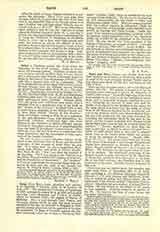

Caius and Soter, SAINTS AND POPES, have their feast together on April 22, on which day they appear in most of the, martyrologies, though Notker and a few others give Soter on the 21st and Caius on the 19th or 21st. Soter was pope for eight years, c. 167 to 175 (Harnack prefers 166-174). We possess a fragment of an interesting letter addressed to him by St. Dionysius of Corinth, who writes: “From the beginning it has been your custom to do good to all the brethren in many ways, and to send alms to many churches in every city, refreshing the poverty of those who sent requests, or giving aid to the brethren in the mines, by the alms which you have had the habit of giving from of old, Romans keeping up the traditional custom of the Romans; which your blessed Bishop Soter has not only preserved, but has even increased, by providing the abundance which he has sent to the saints, and by further consoling with blessed words the brethren who came to him, as a loving father his children.” “Today, therefore, we have kept the holy Lord’s day, on which we have read your letter, which we shall always have to read and be admonished, even as the former letter which was written to us by the ministry of Clement.” (Euseb., Hist. Eccl., IV, xxiv.) The letter which Soter had written in the name of his church is lost, though Harnack and others have attempted to identify it with the so-called “Second Epistle of Clement” (see Clement of Rome). The reverence for the pope’s paternal letter is to be noticed. The traditional generosity of the Roman Church is again referred to by St. Dionysius of Alexandria writing to Pope Dionysius in the middle of the third century, and Eusebius says it still continued in his time. Nothing further is known of this pope.
Caius was pope for twelve years, four months, and seven days, from December 17, 283, to April 22, 296, according to the Liberian catalogue (Harnack, Chronol., I, 155, after Lipsius and Lightfoot); Eusebius is wrong in giving him fifteen years. He is mentioned in the fourth-century “Depositio Episcoporum” (therefore not as a martyr): X kl maii Caii in Callisti. He was buried in the chapel of the popes in that cemetery. Nothing whatever is known of his life. He lived in the time of peace before the last great persecution.
JOHN CHAPMAN

